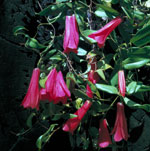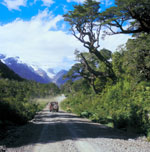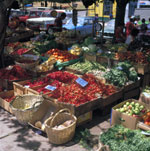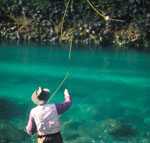Documento sin título
South
Zone
 |
The
lake and volcano region of southern Chile is the expression
of nature in its inimitable beauty and surprising exuberance.
Among volcanic cataclysms, iceberg sculptures,
rain and snow, torrential rivers, and temperate rain forests,
we find a landscape in movement, one that is constantly
modeled and changing before our eyes.
This is the motherland of the Mapuche Indians,
one of South America's most important indigenous cultures.
|
For
almost 300 years, the Mapuches defended the Araucanía, the
northern area of this region, against the Spaniards. They fought,
dispersed, and changed their culture, spreading out over the pampas.
Three centuries of resistance: so much strength! But that is the
nature of the lake region.
Strong, yes, but safe too, and with a European
elegance that is surprisingly familiar. As the Mapuches relinquished
their territory to the newly-independent republic, the European
settlers poured into this paradise of rich volcanic soil, ancient
forests,
and limpid glacier-fed lakes whose waters reflect the range of
active volcanoes towering on the eastern horizon.
EThese
settlers advanced toward the mountains, cutting and burning
their way through the temperate forest. They built cities
throughout the central valley, and ports the length of the
indomitable Pacific coast and on the banks of innumerable
rivers and lakes. The serene landscape of the region's central
valley -wide, rolling meadows, German style haciendas, quiet,
neat towns- can to a large extent be attributed to the hard
work and vision of these 19th century immigrants.
The forests, which so challenged the first
European settlers, are a source of constant awe to the
modern traveler.
There are national and private parks in
Araucanía that protect the last araucaria forests,
an age-old pine native to the region aptly termed in English
the monkey puzzle tree. It dates back to the Jurassic
period and is today a national monument in Chile.
The cities of Temuco and Pucón,
built in the heart of Mapuche country, are gateways to
the wide range of attractions that the region offers,
undoubtedly one of the Chile's prime tourist destinations.
|
 |
 |
LFarther
south, the Valdivia rain forest -the world's second-largest
temperate rain forest- covers the Coastal and Andes mountain
ranges. The cities of Valdivia, Osorno, Puerto Varas, and
Puerto Montt are good places to start exploring the beautiful
Andes lakes, some of which straddle the Chile-Argentina
border.
Still farther south, where the central valley
finally sinks into the Pacific and the Chilean Patagonia
begins, we find magnificent ancient alerce forests, a tree
sometimes referred to as the South American redwood. Some
hard-to-find specimens are over 3500 years old.
|
|
All
of the region's cities offer excellent hotels, restaurants,
shopping centers, and transportation, as well as attractions
for all tastes, ages, and physical fitness levels. Of particular
interest is the chain of national parks that runs along
the border with Argentina and protects numerous ecosystems,
from native forests to volcanic plateaus.
There
are many vacation options for families or people with general
interests. Travelers can choose to visit the parks, take
an Andean lake cruise towards Argentina, or visit a myriad
of vacation spots along the lakeshores. |
 |
For those with more specific interests or adventure seekers, hiking,
mountain climbing, rafting, bird watching, mountain biking, and
horseback riding are just a few of the almost unlimited possibilities
offered by Chile's lake and volcano region.
|
|
|